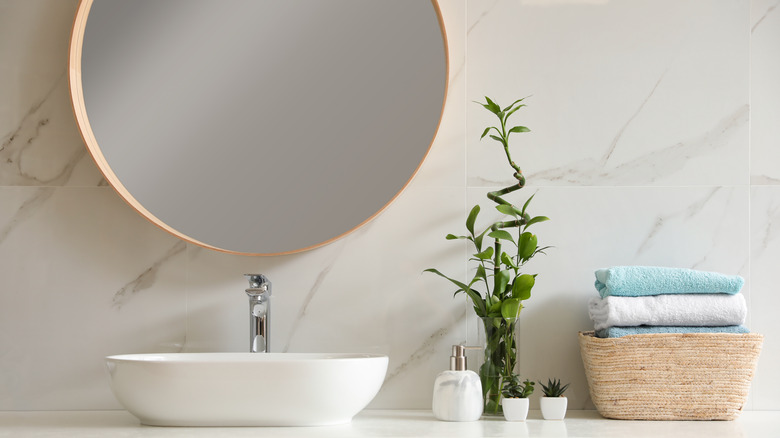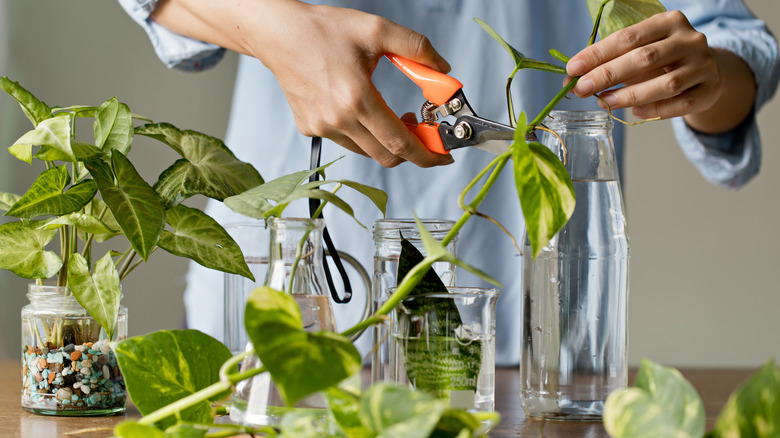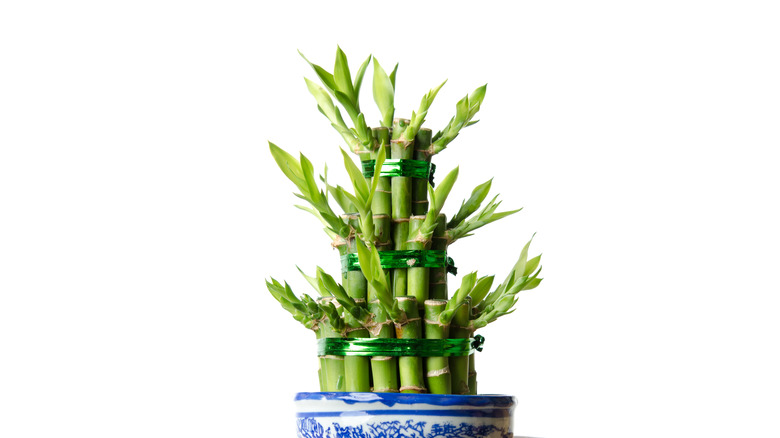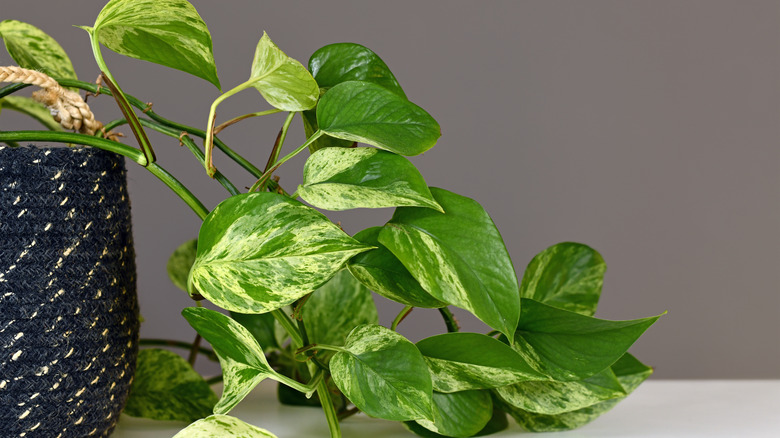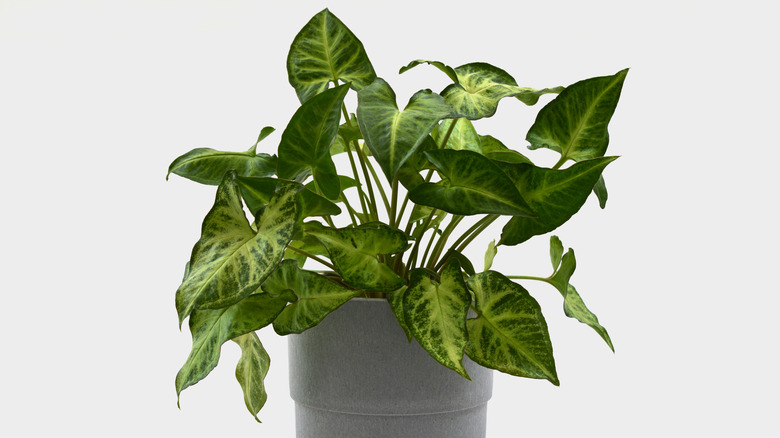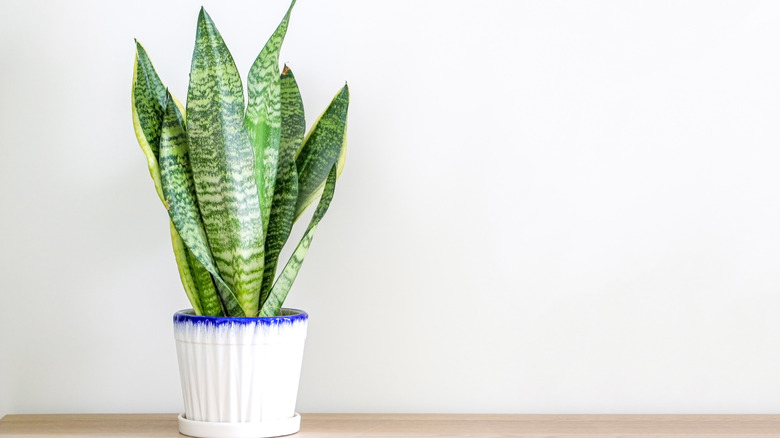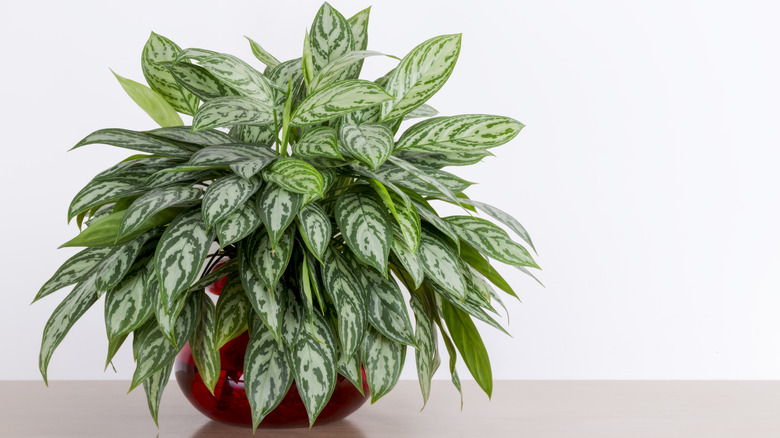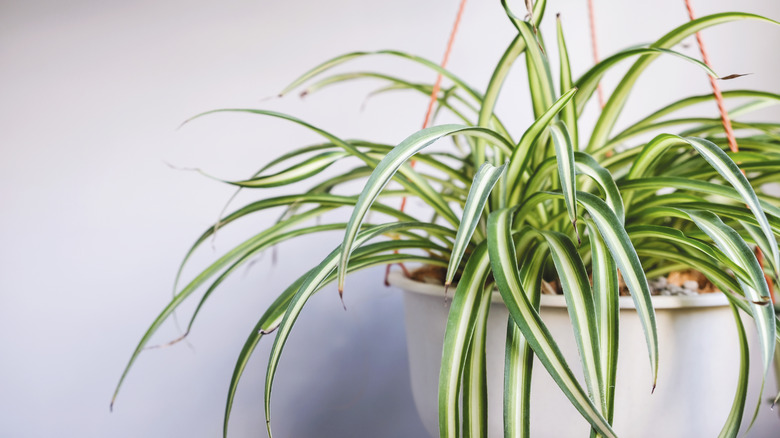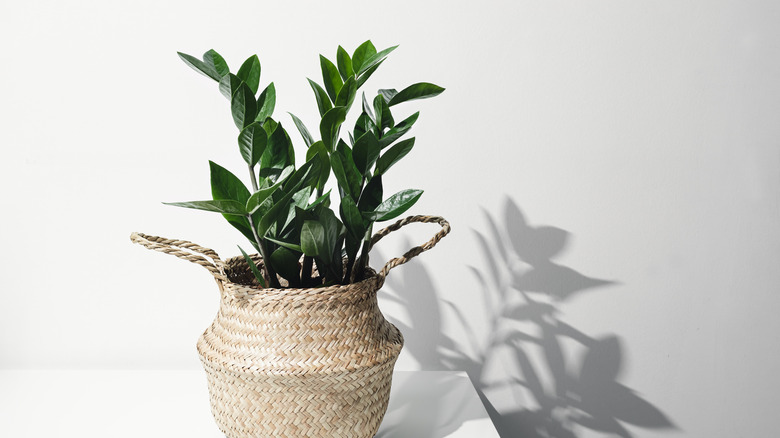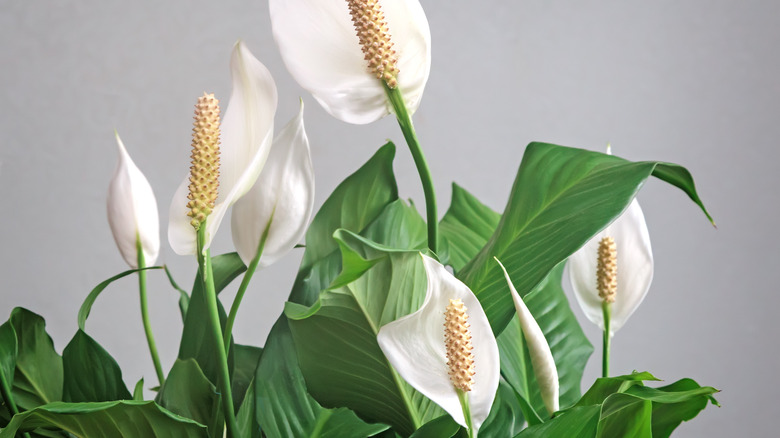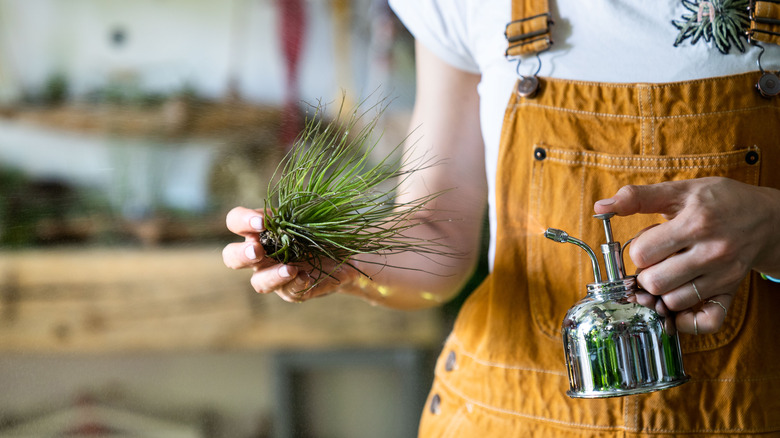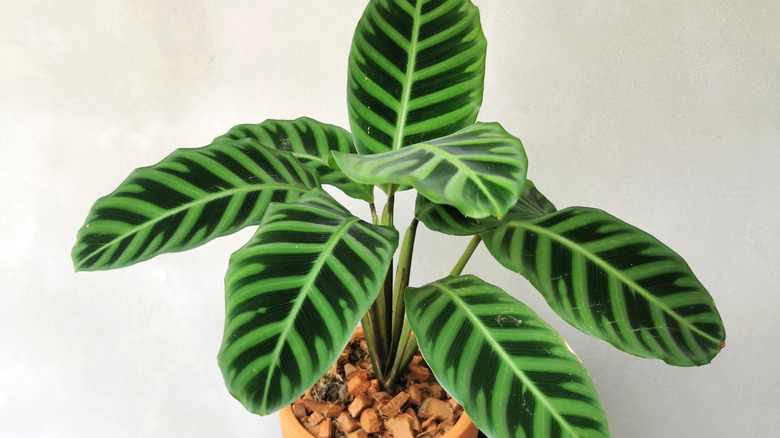Plants That Grow And Thrive In A Windowless Bathroom
The essentials to caring for and keeping indoor plants can be broken down fairly easily: water, sunlight, soil. For those who live in low-light areas or with little access to natural light, it might seem pointless to keep a houseplant. However, this is far from true. Even someplace like a small, windowless bathroom can be used to grow and cultivate houseplants. So much so that it's become an interior design trend.
Shane Pliska, president of Planterra Interior Landscaping, tells Today Home that on projects their company will "always put a plant in the master bedroom spa area ... Even in small spaces, plants can work quite well in the shower." Excess water from daily showers, as well as the humidity from steamy showers, allow certain plants to thrive. And when it comes to lighting, plants that only require low light work great in these spaces, able to undergo photosynthesis with just artificial light. It's even possible to grow plants using LED lights. Greenhouse Today says that with certain parameters in place, it's possible that indoor-grown plants can develop as well as outdoor plants. These parameters include keeping the lights off at night and not too close or far away. With this in mind, the only difficulty will be deciding which plant is right for your space.
Treat your bathroom like a propagation station
If you're anxious to get plants into your home, a great way to get started is to use the bathroom as your plant propagation station. For those who like to create a jungle of plants in the home, propagating plant cuttings is an easy and cost-effective way to reproduce more individual plants.
There are certain environmental requirements needed to propagate, including indirect sunlight and proper watering, according to Stauffers of Kissel Hill. Succulents, for example, need space and indirect, medium light when propagating from a single pad. A bathroom with artificial light is a great spot. Depending on the space you can even line a few near each other and watch as their roots grow. The artificial light will give your plants enough "sunlight" to grow roots without getting scorched from full, direct sun. And the humidity from the shower will help keep their water cups or soil moist.
Typically the easiest method of propagation is cutting, but it entirely depends on the plant (via Gardenista). Snake plants are a great species to propagate by use of cutting. Something like a ZZ plant with multiple stems needs to have its roots pulled apart and divided. No matter the method you use to propagate, the bathroom is a good spot to keep them. Larger plants allow space for big or heavier pots to keep these new growths. For plants that only need water, you can organize these in fun ways. Hang vials of water on a wall rack for an interesting display. Try out using small colored vases to store the propagated roots, lined up on your counter or a shelf.
Lucky bamboo
A beautiful plant with a fascinating history, the lucky bamboo plant is an easy, ideal choice to keep in your sunlight-free bathroom. Though it bears the same resemblance, this plant is technically not a species of bamboo and shares more similarities to succulents, according to Almanac. The name stems from Chinese history, as the plant is said to symbolize luck and good fortune. And lucky for homeowners, these types of plants are inexpensive and easy to find; you've probably spotted them in your grocery store.
Lucky bamboo grows particularly well in the shade, specifically in a space with bright, indirect light — perfect for an artificially lit bathroom. One plant can even grow as many as 21 stalks, and the number of stalks on your plant represents a different type of luck or blessing. Two stalks, for example, represent love, while three represent wealth and happiness. Pebbles are used to help stabilize the stalks, and typically when watering it's best to cover the roots.
For the bathroom, the style of lucky bamboo you choose should depend on the space you have to place one. No matter the size, however, it's advised to keep the plant in a clear, colored container to keep track of water. Lucky bamboo also prefers a warmer climate, above 65 degrees, so a bathroom that stays warm throughout the day and night is best.
Pothos
A gorgeous inclusion to your home, pothos plants are beautiful climbing plants that grow long, trailing tendrils that can stretch across entire walls. This houseplant will spruce up any bathroom, simple or stylized, and will not require a window to grow. According to the University of Wisconsin-Madison, this plant grows best in warmer, humid environments, making it a great plant to keep in bathrooms with showers. Filtered light is also recommended, though if needed it can adapt to other lighting conditions fairly easily.
The best aspects of this plant make it a great beginner plant if you are new to owning houseplants. The only caveat is that because of its growth rate, pothos usually needs to be pruned every so often. This is done to keep the vines from getting too tangled or wild. However, if you're looking to give your bathroom a wild jungle atmosphere, divert your attention to untangling the vines instead of pruning. As mentioned though, cuttings of pothos are great ways to propagate new plants to feature in other parts of the home.
Arrowhead plant
The heart-shaped arrowhead plant is a very easily kept, adaptable plant. The arrowhead plant is unique in its growth patterns, giving homeowners the chance to see different shapes and styles. This depends on how it is cared for and where it is placed. If placed under or near a pole-like structure, the plant can grow trailing upwards with little help needed. This method of growing will change the shape of the leaves, according to Garden Goods Direct. If you desire to keep the standard heart-shaped leaves, it's recommended to prune the trailing leaves, which will keep the plant shorter and bushier.
This plant is one that thrives in bright indirect light, as too much sunlight can scorch its leaves and leave brown spots, according to Mod and Mint. Arrowhead plant is an ideal choice for a bathroom without a window, as long as it has ample artificial lighting. This plant likes moist soil so a regular watering schedule is key. It is also recommended to let the plant dry out between waterings so as not to cause root rot.
To style it within the bathroom, the arrowhead plant is flexible. Its green and white colored leaves and unique leaves can be a great background element if you have a larger bathroom. However, in smaller spaces, this will be a great green focal point.
Snake plant
Snake plants, or Sansevieria trifasciata, are one of the most popular house plants for first-time plant owners. NatureID botanist Halina Shamshur tells Healthline that it's common to find them growing "on windowsills in houses, apartments, and different public buildings." Part of the reason why these plants are especially easy to care for is due to their ability to grow in low light. Shamshur also notes that these species don't require frequent repotting. This means that once they're potted they can remain stationary for quite some time. This works great in windowless bathrooms that can range in humidity and interior styles.
There are many other benefits to keeping snake plants in your home, particularly the bathroom. Shamshur notes that these plants have the ability to remove harmful toxins and airborne allergies. This especially is great for high-traffic areas in the home, such as the bathroom. For pet owners, this can also be helpful with dander. However, these plants are poisonous so should be kept out of reach of your furry friends.
This genus of plant has around 70 different species to choose from, with some of the most popular available in stark designs and bright colors. A Dracaena trifasciata species is one of the most common and features leaves with green-striped leaves with bright yellow along the edges. This type of snake plant works great to brighten up darker corners or bring a pop of color into a space with neutral tones. The best type of planter is a tall plant stand to give it room to grow.
Chinese evergreen
The Chinese evergreen, also known as the Philippine evergreen, is a beautiful plant that is tougher than it looks. For plant owners, this means it does well under harsh conditions, including low or indirect light. The Chinese evergreen's broad leaves help it absorb whatever light is available, giving it this strong durability. And speaking of absorption, this variety of plant was even proven in a clean air study completed by NASA to help purify the air of toxins.
For dimmer or darker bathrooms, however, Garden Design recommends choosing a variety with darker leaves, which tolerate low light better than those with lighter colors. This plant also loves humid environments and moist soil, according to Petal Republic. For the bathroom specifically, this plant would respond well to shower steam. The only other needs to keep in mind for this plant is fertilizer, which is needed monthly during spring and summer, and none in the winter. When choosing your Chinese evergreen, a fun design idea is to go for a smaller plant and showcase it in a macrame hanger. The use of this popular design piece will bring a down-to-earth energy to the space.
Spider plant
The spider plant has long extended leaves that look great sprouting from a hanging pot or one sitting on a shelf. What many might not realize though is how well it works with little to no light. According to My Tasteful Space, a spider plant's resilience in low-light settings makes it a perfect addition to a sunless bathroom. They thrive under fluorescent and artificial lighting, as well as under grow lamps. Light will even affect the look of your spider plant; the more light it receives, the bolder the color of its stripes will appear (via bloomscape). Pair this with the fact that it thrives on high humidity and you have a perfect accent for your windowless bathroom.
Another great feature of the spider plant is its spiderettes, or "pups." These are essentially baby plants that grow off of the main spider plant. These pups are great for propagating and starting new plants, which you can also grow in your bathroom or other spaces throughout the home. Magic Bricks also adds that you can grow spider plants in water as well as soil. This gives you the chance to feature any new growths in water vials or glasses alongside the main plant. This display can be an eye-catching feature in your bathroom.
ZZ plant
Stauffers of Kissel Hill named the ZZ plant an ideal plant to keep in low-light environments, which in some cases can be a bathroom without a window. These types of greenery bring life into the space, particularly with the ZZ plant, which can come in a range of colors, even a dark moody black known as ZZ 'The Raven.' The light it receives, however, should be bright and indirect. In this case, that means a brightly lit bathroom, maybe with multiple light sources.
This plant does well with medium humidity and minimal watering. In fact, you should only water it when the soil is bone dry, according to Planterina. The ZZ plant stores water in its stems, which grow thick from the root ball. If your plant grows too big for its pot, you can propagate this plant easily by breaking up the clustered roots. Other tips to keep this plant healthy are to dust its leaves and allow for vertical growing space. These plants can grow anywhere from two to five feet tall.
Peace lily
Peace lilies are beautiful flowering plants with dark green leaves and white flower petals. Another tolerant plant, this variety is great to host in your windowless bathroom as its light needs range from bright indirect to low light, according to Clemson University. However, peace lily is more than just aesthetically good-looking. It also has character.
The peace lily is a "vocal" plant without having a voice, as it easily shows clear signs when it needs water. According to Our House Plants when the plant needs water it will wilt dramatically as if it has been without water for weeks. For first-time plant owners, this can sometimes seem alarming, but when you learn more about this plant's needs, these signs can actually be a real blessing.
In low-light environments, peace lilies will definitely grow slower than with brighter sunlight. There are ways to encourage new flower growth, from keeping the room a bit on the warmer side to repotting in a slightly larger pot. In terms of design, these will work great in bathrooms in need of color or a sophisticated touch.
Air plants
Air plants are inherently unique for the simple fact that they do not need soil to grow. These plants rely solely on light and water to survive, doing well under artificial lighting based on the variety you choose. Out of the two types of air plants, the Mesic variety would do the best in a windowless bathroom, as it originally comes from more humid areas with lots of shade (via Plantophiles). The only other need of the plant is to get adequate watering or misting, but in a room such as a bathroom that shouldn't be too difficult.
Watering these plants properly depends on how you display them, according to Modern Air Plants. The typical methods include misting which works well for hanging plants or those kept in a terrarium, as well as dunking which works better for Mesic varieties. Whichever method you choose, it's best to let the plants dry completely before putting them back in their container or habitat. These plants also easily grow new pups off of the mother plant, great for propagating and starting a collection in your bathroom.
Calathea
In nature, Calathea plants can be found walking along the jungle floor, according to Ambius, sprouted along the roots of trees. This plant variety thrives on high humidity and indirect sun, making it a great addition to your bathroom decor with limited or no natural sunlight. They are also famously known for having lush coloring and interesting patterns on their leaves, making them a great focal point in your space.
The ideal light for this plant variety is medium to indirect light, which will affect the brightness of its colors, according to Planterina. An increase in light will maintain the colors and patterns of the foliage, and lower light can eventually cause the patterns and colors to fade — which isn't a bad thing, just something to keep in mind if your bathroom is on the dimmer side.
Because of their origins, water is key to keeping these plants healthy. It is recommended to give these plants filtered or purified water, as regular tap water has minerals that will affect the leaf designs as well. Though it requires a bit more upkeep, these beautiful plants make a great statement in your home and bring rich life into whatever corner you place them in.
